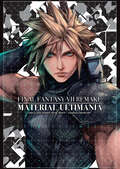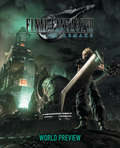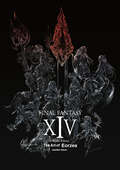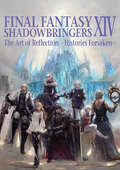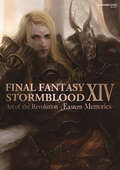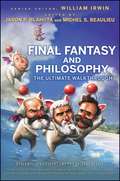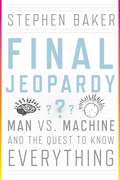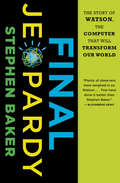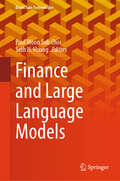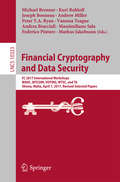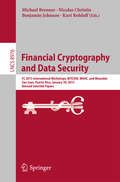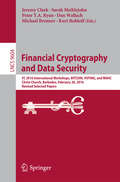- Table View
- List View
Final Fantasy V (Boss Fight Books)
by Chris KohlerWhen Final Fantasy V was released for the Japanese Super Famicom in 1992, the fantasy role-playing game was an instant hit, selling two million copies in the first two months alone. But the game was dubbed too hardcore for a Western audience and was not released outside Japan. That didn't stop a teenage Chris Kohler from tracking down Final Fantasy V. The young RPG fan got a Japanese copy of the game, used it to teach himself Japanese, and with the help of some internet companions created the first-ever comprehensive English-language FAQ of the game. Now the acclaimed author of Power-Up and an editor at Kotaku, Kohler is revisiting the game that started his career in games journalism. Based on new, original interviews with Final Fantasy V's director, Hironobu Sakaguchi, as well as previously untranslated interviews with the rest of the development team, Kohler's book weaves history and criticism to examine one of the Final Fantasy series's greatest and most overlooked titles.
Final Fantasy VI (Boss Fight Books)
by Sebastian DekenTerra the magical half-human. Shadow the mysterious assassin. Celes the tough, tender general. Kefka the fool who would be god. Each of the many unforgettable characters in Final Fantasy VI has made a huge impression on a generation of players, but why do we feel such affection for these 16-bit heroes and villains as so many others fade? The credit goes to the game&’s score, composed by the legendary Nobuo Uematsu. Armed with newly translated interviews and an expert ear for sound, writer and musician Sebastian Deken conducts a critical analysis of the musical structures of FF6, the game that pushed the Super Nintendo&’s sound capabilities to their absolute limits and launched Uematsu&’s reputation as the &“Beethoven of video game music.&” Deken ventures deep into the game&’s lush soundscape—from its expertly crafted leitmotifs to its unforgettable opera sequence—exploring the soundtrack&’s lasting influence and how it helped clear space for game music on classical stages around the world.
Final Fantasy VII Remake: Material Ultimania (Final Fantasy VII)
by Square Enix Studio BentStuff Digital HeartsPacked with art and visual reference materials used during development of the game, this deluxe, hardcover volume is a must-have for fans of Final Fantasy VII Remake.Final Fantasy VII Remake: Material Ultimania presents a comprehensive collection of production art and CG art assets, including character models and illustrations, locations and backgrounds, accessories, weapons, enemies, and more, all accompanied by staff commentary. This volume also includes detailed costume references, cutscene storyboards, song liner notes from the sound staff, and Q & A interviews with the Japanese voice actors.At over 300 pages, this full-color, jacketed, hardcover book is a visual tribute to the stunning new rendition of one of the most beloved RPGs of all time.
Final Fantasy VII Remake: World Preview (Final Fantasy VII)
by Square EnixA full-color, lavishly illustrated introduction to the world of Final Fantasy VII Remake, presenting information on characters, settings, gameplay, and more!With its captivating characters, striking visual design, and intense gameplay, Final Fantasy VII set a new standard for the RPG genre and became one of the top video game releases of all time. Now, with Final Fantasy VII Remake, players return to Midgar in a stunning new rendition of a timeless classic. This World Preview volume offers both new players and longtime fans essential information on characters, settings, gameplay, and more, as well as introductory comments from producer Yoshinori Kitase and director Tetsuya Nomura.
Final Fantasy XIV: A Realm Reborn -- The Art of Eorzea -Another Dawn- (Final Fantasy XIV)
by Square EnixA new edition of the first official art book for Final Fantasy XIV, boasting over 1,000 pieces of full-color artwork, along with comments from the developers and an exclusive bonus item code! (NOTE: E-book edition does not include bonus item code.)Featuring artwork from character designer Akihiko Yoshida and the Final Fantasy XIV art team, A Realm Reborn: The Art of Eorzea –Another Dawn– collects the illustrations created throughout the process of developing the groundbreaking online game. This 300-page, full-color volume showcases beautiful concept designs, environment artwork, sketches and more, accompanied by production notes and comments from the artists. Includes an exclusive bonus item code for an in-game Wind-up Enterprise minion! The first volume in the line of Final Fantasy XIV official art books.
Final Fantasy XIV: Heavensward -- The Art of Ishgard -Stone and Steel- (Final Fantasy XIV #1)
by Square EnixA beautiful new edition of the official art book for Final Fantasy XIV: Heavensward. Featuring hundreds of full-color illustrations and an exclusive bonus item code, this is a must-have for collectors and fans! Book one of a two-book set. (NOTE: E-book edition does not include bonus item code.)The Art of Ishgard -Stone and Steel- presents the concept art and planning images that became the foundation for the aesthetics of Final Fantasy XIV: Heavensward. Each page of this gorgeous, high-quality volume is packed with full-color art and character sketches, as well as lore-related drawings of equipment, environments, and more. Book one of a two-book set with The Art of Ishgard -The Scars of War-.Includes an exclusive bonus item code for an in-game Wind-up Relm minion! The second volume in the line of Final Fantasy XIV official art books.
Final Fantasy XIV: Shadowbringers -- The Art of Reflection -Histories Forsaken- (Final Fantasy XIV #1)
by Square EnixA gorgeous, oversized, full-color art book showcasing the artwork from the massively popular online video game Final Fantasy XIV. Volume one of a two-volume set with The Art of Reflection -Histories Unwritten-.(NOTE: E-book edition does not include bonus item code.)Delve into the breathtaking world of Final Fantasy XIV: Shadowbringers in this deluxe volume featuring hundreds of beautiful illustrations of characters, environments, equipment, and more. Offering concept art, reference images, and messages from the artists, this book is a must-have not only for fans of the game but for any who appreciate top-tier game art.Includes an exclusive bonus code redeemable for a Wind-up Dulia-Chai minion! The sixth volume in the line of Final Fantasy XIV official art books.
Final Fantasy XIV: Shadowbringers -- The Art of Reflection -Histories Unwritten- (Final Fantasy XIV #2)
by Square EnixThe second volume of a two-volume set of the official art books for Final Fantasy XIV: Shadowbringers, featuring hundreds of pages of full-color art and an exclusive bonus item code!Covering content through the end of the Shadowbringers expansion, this deluxe, large-format book showcases artwork for YoRHa: Dark Apocalypse, Eden&’s Verse & Eden&’s Promise, Save the Queen, and much more. The Art of Reflection -Histories Unwritten- also includes detailed illustrations of characters, equipment, dungeons and trials, as well as messages from the artists. Volume two of a two-volume set with The Art of Reflection -Histories Forsaken-.Includes an exclusive bonus item code for a Wind-up Runar minion! (NOTE: E-book edition does not include bonus item code.)The seventh volume in the line of Final Fantasy XIV official art books.
Final Fantasy XIV: Stormblood -- The Art of the Revolution -Eastern Memories- (Final Fantasy XIV #2)
by Square EnixThe second volume of a two-volume set of the official art books for Final Fantasy XIV: Stormblood. This new edition features hundreds of pages of full-color art, a sticker sheet, and an exclusive bonus item code! (NOTE: E-book edition does not include bonus item code.)Return to Eorzea with the Warrior of Light via this exhaustive collection of almost one thousand pieces of concept art and illustrations, including character designs, field areas, dungeons, monsters, equipment, and more. Covering content through the end of the Stormblood expansion, The Art of the Revolution -Eastern Memories- also features messages from the art team, along with a job stone and minion sticker sheet. Book two of a two-book set with The Art of the Revolution -Western Memories-.Includes an exclusive bonus item code for an in-game Dress-Up Tataru minion! The fifth volume in the line of Final Fantasy XIV official art books.
Final Fantasy XIV: Stormblood -- The Art of the Revolution -Western Memories- (Final Fantasy XIV #1)
by Square EnixShowcasing the stunning artwork of Final Fantasy XIV: Stormblood, this new edition of the official art book offers hundreds of full-color illustrations in a collectors' quality volume, along with an exclusive bonus item code. Book one of a two-book set. (NOTE: E-book edition does not include bonus item code.)Experience the rich world of Final Fantasy XIV: Stormblood once more via this exhaustive collection of concept art and illustrations, including character designs, field areas, dungeons, monsters, equipment, and more. The Art of the Revolution -Western Memories- also features commentary from the art team on how costumes are created. Book one of a two-book set with The Art of the Revolution -Eastern Memories- Includes an exclusive bonus item code for an in-game Wind-up Yotsuyu minion! The fourth volume in the line of Final Fantasy XIV official art books.
Final Fantasy XV Official Works
by Square EnixA full-color, oversized, hardcover tome that faithfully adapts the original Japanese material, detailing the creation of the most recent entry in the Final Fantasy saga!Final Fantasy XV's world of Eos is filled with wonderous scenery, larger-than-life creatures, diverse cultures, and treacherous foes. Experience hundreds of pieces of detailed design work composed lovingly for fans of the unique sci-fi fantasy world. This volume collects complex lore, insightful commentary, comprehensive data, and dazzling concept art, all beautifully bound in this richly detailed hardcover!Square Enix and Dark Horse Books present a superbly curated collection of Final Fantasy XV content that any fan will cherish.
Final Fantasy and Philosophy: The Ultimate Walkthrough
by P. Blahuta Michel S. BeaulieuEverything you need to achieve a greater understanding of Final Fantasy and transform your status is here: the Basic Controls, Playing the Game, Abilities, Side Quests, and Other Ways to Enjoy the Game. Mages, Moogles, Fiends, and Kefka, however, have been mashed together with the likes of Machiavelli, Marx, Foucault, and Kafka. The result, we hope, will launch you into your own philosophical quests of Final Fantasy and beyond. And, of course, your intellectual status will be forever changed on reading this book.
Final Jeopardy: Man vs. Machine and the Quest to Know Everything
by Stephen BakerTechnology journalist Baker reveals the story behind Watson, the IBM computer designed specifically to compete in the television quiz show Jeopardy! against some of the show's greatest champions. The nature of the show, with puns and other forms of wordplay complicating the task of recalling the wide range of knowledge prompted by Jeopardy!'s "answers," posed a significant challenge in artificial intelligence design, in some ways a far more subtle challenge than that faced by IBM's chess-playing computer, Deep Blue. Baker discusses the people behind the program, the origins and progress of the program, the computing and artificial intelligence issues raised, and related topics. (Following publication, Watson handily trounced former Jeopardy! champions Ken Jennings and Brad Rutter in the televised challenge. ) Annotation ©2011 Book News, Inc. , Portland, OR (booknews. com)
Final Jeopardy: The Story of Watson, the Computer That Will Transform Our World
by Stephen BakerThe &“charming and terrifying&” story of IBM&’s breakthrough in artificial intelligence, from the Business Week technology writer and author of The Numerati (Publishers Weekly, starred review). For centuries, people have dreamed of creating a machine that thinks like a human. Scientists have made progress: computers can now beat chess grandmasters and help prevent terrorist attacks. Yet we still await a machine that exhibits the rich complexity of human thought—one that doesn&’t just crunch numbers, or take us to a relevant web page, but understands and communicates with us. With the creation of Watson, IBM&’s Jeopardy!-playing computer, we are one step closer to that goal. In Final Jeopardy, Stephen Baker traces the arc of Watson&’s &“life,&” from its birth in the IBM labs to its big night on the podium. We meet Hollywood moguls and Jeopardy! masters, genius computer programmers and ambitious scientists, including Watson&’s eccentric creator, David Ferrucci. We see how Watson&’s breakthroughs and the future of artificial intelligence could transform medicine, law, marketing, and even science itself, as machines process huge amounts of data at lightning speed, answer our questions, and possibly come up with new hypotheses. As fast and fun as the game itself, Final Jeopardy shows how smart machines will fit into our world—and how they&’ll disrupt it. &“The place to go if you&’re really interested in this version of the quest for creating Artificial Intelligence.&” —The Seattle Times &“Like Tracy Kidder&’s Soul of a New Machine, Baker&’s book finds us at the dawn of a singularity. It&’s an excellent case study, and does good double duty as a Philip K. Dick scenario, too.&” —Kirkus Reviews &“Like a cross between Born Yesterday and 2001: A Space Odyssey, Baker&’s narrative is both . . . an entertaining romp through the field of artificial intelligence—and a sobering glimpse of things to come.&” —Publishers Weekly, starred review
Finally Heard
by Kelly YangFrom the New York Times bestselling author of Front Desk comes the sequel to Finally Seen &“that tackles tweenhood and technology woes head-on&” (School Library Journal, starred review) when Lina tries to navigate social media, only to discover not everything online is what it seems.When ten-year-old Lina Gao sees her mom&’s video on social media take off, she&’s captivated by the potential to be seen and heard! Maybe online she can finally find the confidence she craves. Whereas in real life she&’s growing so fast, she feels like microwave popcorn, bursting out of her skin! With the help of her two best friends, Carla and Finn, and her little sister, Millie, Lina sets off to go viral. Except there&’s a lot more to social media than Lina ever imagined, like: 1. Seeing inside her classmates&’ lives! Is she really the only person on the planet who doesn&’t have a walk-in closet? 2. Group chats! Disappearing videos! What is everyone talking about in the secret chats? And how can she join? 3. A bazillion stories about what to eat, wear, and put on her face. Could they all be telling the truth? Everyone sounds so sure of what they&’re saying! As Lina descends deeper and deeper into social media, it will take all her strength to break free from the likes and find the courage to be her authentic self in this fast-paced world.
Finance 4.0 - Towards a Socio-Ecological Finance System: A Participatory Framework to Promote Sustainability (SpringerBriefs in Applied Sciences and Technology)
by Dirk Helbing Marcus M. Dapp Stefan KlauserThis Open Access book outlines ideas for a novel, scalable and, above all, sustainable financial system.We all know that today’s global markets are unsustainable and global governance is not effective enough. Given this situation, could one boost smart human coordination, sustainability and resilience by tweaking society at its core: the monetary system? A Computational Social Science team at ETH Zürich has indeed worked on a concept and little demonstrator for a new financial system, called “Finance 4.0” or just “FIN4”, which combines blockchain technology with the Internet of Things (“IoT”). What if communities could reward sustainable actions by issuing their own money (“tokens”)? Would people behave differently, when various externalities became visible and were actionable through cryptographic tokens? Could a novel, participatory, multi-dimensional financial system be created? Could it be run by the people for the people and lead to more societal resilience than today’s financial system (which is effectively one-dimensional due to its almost frictionless exchange)? How could one manage such a system in an ethical and democratic way? This book presents some early attempts in a nascent field, but provides a fresh view on what cryptoeconomic systems could do for us, for a circular economy, and for scalable, sustainable action.
Finance Transformation: Leadership on Digital Transformation and Disruptive Innovation
by Tarnveer Singh Aikta VarmaFinance Transformation: Leadership on Digital Transformation and Disruptive Innovation is a general and wide-ranging survey of finance transformation and emerging technologies. Finance and IT have long been important areas of any business, but recent technological developments are innovating and disrupting both. This book lays a path towards the benefits and away from potential risks. It covers the widest array of topics, from quantum computing to blockchain technology, from organisational culture and diversity to hybrid working, and from regulation to cybersecurity. Written by two vastly experienced industry professionals, this book includes real-life examples and up-to-date references. It will be of particular interest to business stakeholders, executives, and policymakers.
Finance and Large Language Models (Blockchain Technologies)
by Paul Moon Sub Choi Seth H. HuangThis book highlights how AI agents and Large Language Models (LLMs) are set to revolutionize the finance and trading sectors in unprecedented ways. These technologies bring a new level of sophistication to data analysis and decision-making, enabling real-time processing of vast and complex datasets with unparalleled accuracy and speed. AI agents, equipped with advanced machine learning algorithms, can identify patterns and predict market trends with a level of precision that may soon surpass human capabilities. LLMs, on the other hand, facilitate the interpretation and synthesis of unstructured data, such as financial news, reports, and social media sentiments, providing deeper insights and more informed trading strategies. This convergence of AI and LLM technology not only enhances the efficiency and profitability of trading operations but also introduces a paradigm shift in risk management, compliance, and personalized financial services. As these technologies continue to evolve, they promise to democratize access to sophisticated trading tools and insights, leveling the playing field for individual traders and smaller financial institutions while driving innovation and growth across the entire financial ecosystem.
Finance and Law in the Metaverse World: Regulation and Financial Innovation in the Virtual World (Contributions to Finance and Accounting)
by Nadia Mansour Lorenzo M. Bujosa VadellThis edited volume examines the impact of the metaverse on finance and law. As the commercial development of the internet and digital technology has done for more than thirty years, the metaverse phenomenon raises questions about the relevance of existing legal rules in dealing with new practices: between the need for adaptation, evolution, or new rules. While the Blockchain ecosystem has developed steadily over the last few years and its applications are still evolving, can we assume that the metaverse will become "the most prodigious phenomenon of the 21st century"? The term metaverse refers to a virtual world. Technically, using known but evolving technologies, the term refers to a network of 3D virtual worlds. In its current state of development, there is a metaverse and not a single virtual world as there is an internal one, simply because its development is still dependent on proprietary technologies. The development of the metaverse is no less accurate, and a few recent examples suggest that lawyers will not be able to escape this phenomenon, which looks set to involve individuals, companies, and institutions. The financial world is not immune to the emergence of the metaverse either. Traditional finance is moving into new virtual worlds. Several banks and insurance companies are entering this world, far removed from their traditions. Some have even set up branches there. However, what are these financial institutions trying to achieve by entering this market segment? This book addresses these questions with contributions from academics and experts from both fields.
Financial Analysis and Risk Management: Data Governance, Analytics and Life Cycle Management
by Victoria LemieuxThe Global Financial Crisis and the Eurozone crisis that has followed have drawn attention to weaknesses in financial records, information and data. These weaknesses have led to operational risks in financial institutions, flawed bankruptcy and foreclosure proceedings following the Crisis, and inadequacies in financial supervisors' access to records and information for the purposes of a prudential response. Research is needed to identify the practices that will provide the records, information and data needed to support more effective financial analysis and risk management. The unique contribution of this volume is in bringing together researchers in distinct domains that seldom interact to identify theoretical, technological, policy and practical issues related to the management of financial records, information and data. The book will, therefore, appeal to researchers or advanced practitioners in the field of finance and those with an interest in risk management, computer science, cognitive science, sociology, management information systems, information science, and archival science as applied to the financial domain.
Financial Crimes: A Threat to Global Security
by Maximillian Edelbacher, Peter Kratcoski and Michael TheilFinancial market reform has focused chiefly on the threats to stability arising from the risky, uncontrolled activity of the leaders of financial institutions. Nevertheless, organized crime, white-collar crime, and corruption have a huge impact on financial systems worldwide and must also be confronted if true reform is to be achieved. A collection
Financial Crimes: A Threat to Global Security (Advances in Police Theory and Practice)
by Peter Kratcoski Michael Theil Maximillian EdelbacherFinancial market reform has focused chiefly on the threats to stability arising from the risky, uncontrolled activity of the leaders of financial institutions. Nevertheless, organized crime, white-collar crime, and corruption have a huge impact on financial systems worldwide and must also be confronted if true reform is to be achieved. A collection
Financial Cryptography and Data Security
by Michael Brenner Andrew Miller Markus Jakobsson Joseph Bonneau Kurt Rohloff Vanessa Teague Peter Y.A. Ryan Andrea Bracciali Massimiliano Sala Federico PintoreThis book constitutes the thoroughly refereed post-conference proceedings of the workshop on Usable Security, USEC 2013, and the third Workshop on Applied Homomorphic Cryptography, WAHC 2013, held in conjunction with the 17th International Conference on Financial Cryptology and Data Security, FC 2013, in Okinawa, Japan. The 16 revised full papers presented were carefully selected from numerous submissions and cover all aspects of data security. The goal of the USEC workshop was to engage on all aspects of human factors and usability in the context of security. The goal of the WAHC workshop was to bring together professionals, researchers and practitioners in the area of computer security and applied cryptography with an interest in practical applications of homomorphic encryption, secure function evaluation, private information retrieval or searchable encryption to present, discuss, and share the latest findings in the field, and to exchange ideas that address real-world problems with practical solutions using homomorphic cryptography.
Financial Cryptography and Data Security
by Michael Brenner Nicolas Christin Benjamin Johnson Kurt RohloffThis book constitutes the refereed proceedings of three workshops held at the 19th International Conference on Financial Cryptography and Data Security, FC 2015, in San Juan, Puerto Rico, in January 2015. The 22 full papers presented were carefully reviewed and selected from 39 submissions. They feature the outcome of the Second Workshop on Bitcoin Research, BITCOIN 2015, the Third Workshop on Encrypted Computing and Applied Homomorphic Cryptography, WAHC 2015, and the First Workshop on Wearable Security and Privacy, Wearable 2015.
Financial Cryptography and Data Security
by Michael Brenner Kurt Rohloff Jeremy Clark Sarah Meiklejohn Peter Y.A. Ryan Dan WallachThis book constitutes the thoroughly refereed post-conference proceedings of the workshop on Usable Security, USEC 2013, and the third Workshop on Applied Homomorphic Cryptography, WAHC 2013, held in conjunction with the 17th International Conference on Financial Cryptology and Data Security, FC 2013, in Okinawa, Japan. The 16 revised full papers presented were carefully selected from numerous submissions and cover all aspects of data security. The goal of the USEC workshop was to engage on all aspects of human factors and usability in the context of security. The goal of the WAHC workshop was to bring together professionals, researchers and practitioners in the area of computer security and applied cryptography with an interest in practical applications of homomorphic encryption, secure function evaluation, private information retrieval or searchable encryption to present, discuss, and share the latest findings in the field, and to exchange ideas that address real-world problems with practical solutions using homomorphic cryptography.


